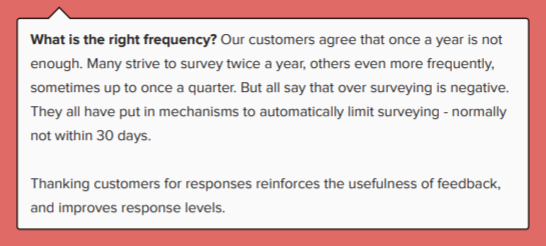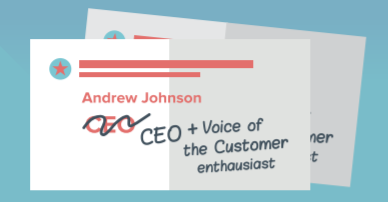NPS® strategies
The Net Promoter® System is a customer experience tool that is suited to do one thing: create growth through loyalty.
By understanding loyalty companies can make calculated strategies to retain more customers, upsell and spread positive word of mouth.
As companies become more experienced with NPS, new challenges present themselves.
The choice then, is whether companies let these challenges become a problem or an opportunity.
This guide aims to help experienced NPS users turn these challenges into profitable opportunities.
#1 Don’t let analysis become your paralysis - take action!
With just two or three questions, the Net Promoter System is able to provide a wealth of insight and understanding. However, many companies get caught carrying out lengthy data analysis while their customers’ problems remain unresolved.
Although NPS does also function as a tool for finding large trends, the true beauty and essence of NPS is about just three simple things:
1) Identifying detractors: your most important customers at risk of leaving.
2) Understand customers who are promoters, and what you are doing well.
3) Rescuing detractors to secure revenue, and activating promoters to grow business by referrals.
To utilize the potential of these three factors companies should act with velocity. For the more time that passes, the more diminished becomes the effectiveness of efforts to retain customers, increase spend value and activate referral capacity.
“But wait! I am already responding to my customers fast!”
This is about acting on feedback fast. Not all customers are asking to have a conversation but their feedback may still require immediate action. So be quick and take action!

#2 Distribute customer experience according to customer revenue
Most companies have a skewed revenue base that follows the 80/20 rule (also known as Pareto). This rule states that 80% of revenue comes from 20% of customers. So as customers aren’t created equal, you might not want to treat them equally.
By linking a revenue value to the NPS score of a customer, valuable insights come to light. In one graph the differences between your VIP group of higher paying customers and the rest become apparent.
There is more to it than just repeat revenue: Customers that spent big did so because your products and services were valuable to them.
Continue to reinforce this belief through personalized customer experience. You will
not only solidify their loyalty but have customers that spend more and create strong
word of mouth.
Unhealthy relationship? At the other end of the spectrum, it might be time to call it quits with those not so healthy relationships. Do you have customers that spend little and create headaches for your company and staff? If this is the case, it may not be worth the time and resources to retain.
The old adage “the customer is always right” only applies if that customer is giving something back.
A relationship has to be a two way street. Calculate how much service lower paying customers should receive. And for those that continue to demand a premium service for minimum spend, the choice needs to be made between attempting to increase their spend value or letting them go.
#3 Action and reaction: Are you repeating your surveys?

NPS is a closed circuit system, meaning that the effects of previous customer experience actions need to be investigated for a company’s customer experience to improve.
The unconscious assumption we often make:
A customer reports a problem, an according action is taken, the action resolves the
problem, ergo why waste time measuring the effect?
We all know this linear conception exists only in the lab. Here, Messages are transmitted clearly and understood precisely, and actions have no additional effects. The real world is a place of poor communication and misunderstood meanings, where actions taken to fix one problem can often cause another.
To learn whether the experience for customers has become better or worse, repeat surveys regularly. Did the actions taken last time to resolve a particular customer’s issue, succeed or not?
Without surveying regularly companies lose the opportunity to create and improve upon internal benchmarks, at both the company wide and case-by-case level. Remove doubt from the equation, survey regularly and discover what did and didn’t work.

#4 Don’t get distracted, keep NPS at center of your business

Corporate priorities and interests shift, and as your NPS program becomes “part of the furniture”, it and customer experience can be pushed aside.
Effective NPS and customer experience means keeping them front and center of a business’s principles and practices.
The Story: In the beginning, companies work to create well-functioning customer experience strategies and teams. For a period, it is a core focus of the business.
They employ NPS as a tool to improve their customer experience. Both NPS and customer experience are integrated horizontally rather than constricted within silos, and are directed and overseen by upper management.
However, as companies become comfortable with NPS and feel they have that base
covered, companies often turn their attention to other matters at the expense of NPS and customer experience.
The Effect: Without a particularly skillful customer experience manager, functionalizing NPS and customer experience will mean that once again it becomes the concern of just one department. And in doing so, NPS and customer experience will fail to be practiced company-wide.
A Solution: Don’t make NPS and customer experience part of one team; it will suffer from poor cross-functionality. It needs to remain a directive that comes from the top; your CEO should also be your head of Customer Experience.
A Conciliatory Note: This is not to say that companies cannot pursue other issues once NPS is well in place. It is simply that NPS and customer experience remain a part of company practice, for everyone.

#5 Activate the power of promoters
Powerful but often overlooked is the referral capacity of those customers that give you a 9 or a 10.
Too many, focus on the reactive nature of NPS rather than the proactive. While a big part of a company’s customer base is saying they love what they do, they’re too busy focusing on those that aren’t so crazy about what they do.
Continue rescuing at risk customers though – recurring revenue is vital to steady predictable growth – but don’t forget the strength that word of mouth has to generate new sales.
With 9 out of 10 consumers stating they believe recommendations from friends and family over all other forms of advertising, word of mouth is an asset that is more effective and cheaper than traditional marketing.
Activate your promoters by giving them incentives to really start talking about you, such as:
- Exclusive sales or deals.
- Provide free gifts to top spenders.
- Give exclusive access to new products before release dates.
- Provide discounts to customers who bring in new customers.
- Host events inviting your top customers.
- Make sure they leave wanting to talk about your brand.
- Provide online platforms for promoters to get their voice out there – forums, social media platforms, etc.
Whether it’s b2b or b2c, promoters that love what you do will talk about you, but some still need that little push to get them started.

#6 Engage employees, make NPS visible company wide
An organization is only as engaged as you allow them to be. If employees don’t know
about your NPS, can they really be blamed for a lack of commitment to the customer?
Make NPS scores and comments visible to everyone in the company to keep the customer front and center of the daily experience.
Why?
Making both the score and comments visible throughout the organization means employees are consistently aware of what is being said about the company and how the score is changing over time.
Why is this good? New initiatives or measures introduced often fail to be fully implemented by employees. For not being part of the process often means employees fail to understand the origin behind new measures and often don’t see the results of such efforts.
Having the voice of the customer throughout a company creates a sense of inclusiveness. Employees better understand customer experience directives and are far more engaged in carrying them out.
Company-wide visible feedback creates self-reflection. As employees view and think
about feedback, they reflect on their own position, how it relate to them and what they can do better.
How?
Use digital signage throughout the organization to display rolling customer feedback and NPS scores.
Use screens that display feedback and scores directly from your NPS tool. Make sure they are large enough that employees can read them easily from a distance. If employees are struggling to read displays then they just won’t read them.
When?
First and foremost, make sure digital signage displays your NPS in real-time. When your score changes or new feedback arrives, your employees should know about it. Don’t wait until the end of a survey round to display new feedback or update your displays at predefined intervals of time.
Pay attention to how you survey your customers. If you survey your customer base
all at once, your feedback will be received in a very short time. This means that as real-time displays start to show old feedback they will quickly lose their effect, as employees will stop paying attention to them.
Stagger your surveys throughout the year so that you continually have new feedback. While although not ideal for every company, transactional based NPS (post transaction or touchpoint) is perfect for creating continual new feedback.
Summary
- Take action today on what your customers are telling you.
- Distribute your customer experience according to the revenue your customers spend.
- Repeat your surveys regularly to learn what did and didn’t work.
- Don’t let NPS lose its priority - keep it front and center and as an upper management directive.
- Don’t just save at risk customers, activate the referral power of your promoters.
- Make sure NPS is visible to everyone in the company, not just some filed away report.
About CustomerGauge
CustomerGauge helps clients improve customer experiences. The system automatically collects, measures and analyses customer feedback and has close-loop tools to retain customers better and reduce churn. All based on the industry standard metric Net Promoter System.
Want to learn more?
Connect with us and visit CustomerGauge.com for more related content.
https://twitter.com/customerga...
https://www.linkedin.com/custo...
https://customergauge.com
